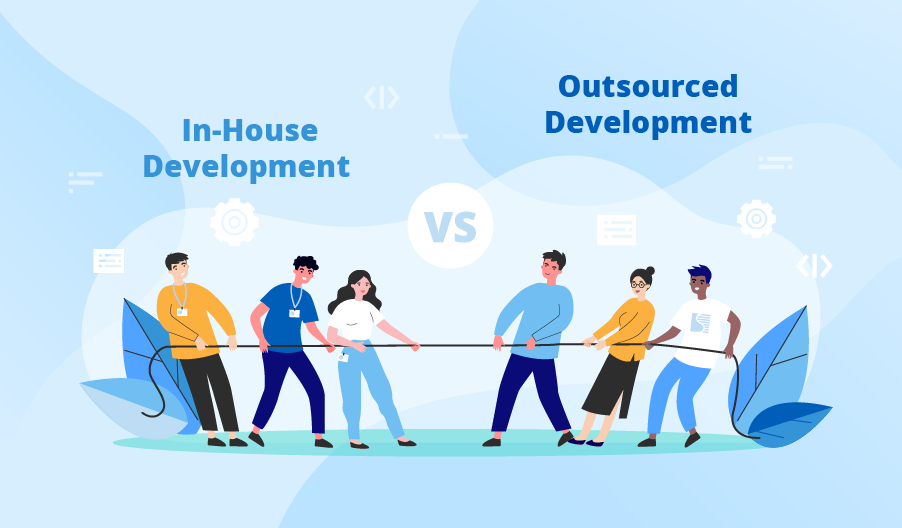Cost and control. While these two elements shouldn't be your sole deciding considerations in determining whether to move forward with a project or not, let's face it—they frequently do.
In general, businesses seek to have as much control as they can while minimising costs. These primary motivators mean that when it comes to the adoption of new software, organisations frequently have to consider the advantages and disadvantages of two distinct approaches: building from the ground up internally or purchasing something ready-made and out of the box.

Although it may appear that developing software in-house would be the superior option because it would give you full control over it, it's not quite that simple.
How can digital publishers choose whether to build necessary tech internally or engage with a third-party source given the urgent need for new technology?
In this blog, we will present the key things you need to take into account when comparing building software vs. buying software.
Is it cost-effective to build your own software?

Every path has the potential to cost you more than you had anticipated, which is an inevitable fact. However, although many firms will try to persuade themselves that developing software in-house will be cheaper and easier, this rarely happens.
This is due, in part, to the fact that, if you opt to develop your own software internally, you'll need to manage the project, assemble a team, and determine (as accurately as you can) how much it will cost.
Even if you've managed similar projects in the past, it's always challenging to give a precise cost estimate; therefore, that's one of the pitfalls of using this strategy.
Hidden cost
A common defence in favour of in-house development is that external tech providers charge higher prices. In real life, this is not always true. This misconception results from an inaccurate estimation of upfront expenses.
Although using a third party may initially cost more, trying to handle everything yourself sometimes results in hidden costs that soar and end up being more expensive than using outside providers.
It's crucial to consider every internal expense necessary to properly develop and manage your own tech. This may consist of:
- The new recruits and obtaining the necessary knowledge
- The project management and firefighting
- The routine maintenance.
- The upgraded equipment and training
- Regular operating expenses
These unforeseen expenses of developing internally are frequently disregarded. The New York Times spent $40 million building its own paywall system, which would surprise many publications.
Does building software in-house instead of buying from a vendor give you more control?
Once again, this is a complex topic to investigate, and perhaps the solution is not quite as simple as it first appears.
You might be excused for believing that choosing to develop a software solution in-house would provide you with more control than doing so by purchasing one from a vendor. You are in charge; you own it and can modify it whenever you want. It's not quite that easy, though.

Yes, if you create your own software instead of purchasing something pre-made that you have no control over, you technically have the flexibility to modify it whenever you want. However, this strategy might still have problems.
When you create custom software in-house for your company, you are dependent on the programmers who build it for you.
Are all of the employees you brought on during the development stage going to stay on when the project is over, depending on how many you hired? If not, who will continue to update the program and fix any bugs? Is the source code easily editable by another developer if they decide to modify the project later?
Depending on who you choose to deal with, you (should) really have more control over vendor software than you may initially assume. Although you won't 'own' the source code, you will be able to make suggestions, offer comments, and participate in the creation of new features and upgrades.
Due to market changes and intense competition, organisations that purchase software from suppliers today have a lot more influence than they ever had.
Of course, if you decide to create your own software in-house, you won't have to worry about your partner's roadmap conflicting with yours because you can accomplish this internally. But if you work with the proper vendor, you'll have more freedom and control over the process of product design and improvement.
In conclusion, use vendor software if you want the advantages of having some "control" without having to deal with software maintenance and upkeep!
Tech suppliers take a comprehensive approach
Since new technology in the publishing value chain evolves quickly, it's common for market shifts to occur before your company has a chance to put a notion into practice. As a consequence, before the project is finished, you could begin an internal project for a particular piece of technology that quickly becomes outdated!

This is less of a problem with external suppliers because they need to be informed and aware of industry developments to stay competitive and ahead of the curve. This entails keeping an eye on the competition as well as assessing the various technologies that emerge or are favoured by digital publishing companies. To better serve their consumers, providers may then determine what is working and what isn't, as well as which technologies they need to integrate with. Some additional advantages of using a tech supplier are:
- Existing vendors expend years of engineering effort
- Thousands of man hours in development, feature rich
- Decades of knowledge in CMS, Content Monetisation, Scalability and Security
- Client Codeless strategy adopted
- Full interoperability between features
- Auto Scaling
This enables them to provide their clients a best-in-class solution that, over time, will save both time and money. Furthermore, given how fiercely competitive the digital publishing market is, it is in the best interests of publishers to keep up with technological advancements in order to gain an advantage over rivals.
Conclusion

In our opinion, it's often better for businesses to spend money on the software that helps them accomplish what they do best rather than getting bogged down attempting to develop it themselves. (Obviously, considering that we are a supplier, it is expected that we would make this argument.)
It's a practical strategy that grants you access to specialised software and the developer's knowledge. Additionally, it eliminates the chance of being mired down in an IT project, which may easily go over budget and past the deadline.
When publishers do decide to work with a vendor, it's crucial for both parties to be clear about what is expected of them. In all honesty, it doesn't make sense for vendors to deal with clients who aren't enthusiastic about the idea of continuing their relationship. We have a well-defined strategy for the future and are always considering how we can help our partners more effectively.
Having said that, it's always crucial that you get a clear awareness of both the requirements of your organisation and the options on the market before making a final selection. Everyone has a distinct view of what is right or wrong, and some views are more legitimate than others. Because of this, you must conduct your study and come to the best decision possible for your situation, supported by the necessary facts.
About Us
Evolok is the total, modular solution for sophisticated digital subscriptions. Tailored to meet your unique needs, the Evolok platform lets you create incredible experiences for your users and unlock your content’s true revenue potential. Evolok is proud to create a world-leading digital subscription platform, combining identity management, access management, engagement and monetisation capabilities, that enables online publishers to leverage their content's appeal and maximise subscription revenues. To know more contact us today.

